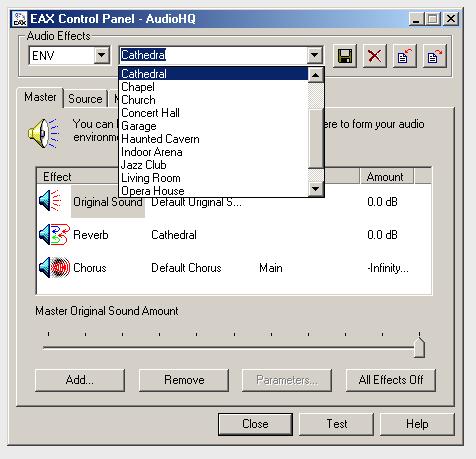|
Creative Labs Audigy Review
|
Posted: December 6, 2001
Written by: Adam Honek
Get EAXcited
EAX Advanced HD
NEWS - it's just been announced that Soldier of Fortune 2 will support
EAX Advanced HD. This is important info as it illustrates that key games
developers are starting to incorporate it into the latest games. Check here for more info.
Within this review we have mentioned the Audigy's new
capability of processing up to four rich audio effects all in one go in real-time.
Anything we hear through the speakers we can re-engineer to sound different by
using any of the EAX special effects. They fall into the following categories:
Environments, Advanced HQ and Special effects. The most distinctive of these is
the option of specifying what type of environment we are in. The sound developed
via the speakers will change accordingly to the environment we specify. For
example if we like to sing in the bathroom we may define EAX to make it appear
as though our computer is located within a bathroom. If for instance one desires
to have the feeling he or she is at a concert they can select "Concert Hall" as
the environment setting. The results are surprisingly very realistic adding a
fine tuning to what we hear. Any of the 16 environments can be mixed with other
effects depending on our personal preferences, some people prefer to hear vocals
over drums and bass, while others want to hear rock music albeit in a classical
flavor. There is a lot to choose from, all easily accessible either using the
remote control's EAX button or via AudioHQ in the Control Panel. We are no
longer tied to the default interpretation how a song is heard by an audience of
one listener or more, now we are in control. An aspect worth mentioning
is that none of these require developer support, once we select the feature we
want, it's automatically applied at the same time we select it.

Audio can be re-engineered by applying EAX audio effects. |
I am hearing 24bit or is
that 16bit?
Creative
uses marketing a lot, and here is no exception. To understand the real truth
behind what the 24bit printed on the box implies we need to dive into the card's
guts. The first thing to point out is yes both the DAC and ADC (digital/analog
converts) developed within the Audigy family of cards are indeed 24bit. The part
that isn't 24bit is the same old task or processing the audio at the usual
16bit/48KHz rate. 24bit converters come in handy within the Audigy because of
what the card was designed in the hope to do. By this we may associate how much
audio will it ever be given the job of producing for a game, movie or a given
MP3 file as an example. The added headroom the extra 8bits add gives the Audigy
less of a bottleneck when there is multiple streams of 16bit samples flowing
through the card.
Every sound card can produce sounds, but one main difference
between will be how efficiently.Here the Audigy is developed to excel, give it
more audio to process and it won't degrade the quality whereas most other
consumer based sound cards will. Given the card is claimed to be 24bit this is
only true if you're referring to the converters, otherwise you may rest quite
assured it still speaks the 16bit language internally. A 100dB SNR
(Signal-to-Noise Ratio) as offered by the new Audigy matches that of modern
high-end home theater systems. In practice combining this with the 24bit DAC and
ADC will output clean streams of audio. Without 100dB SNR other features such as
Audio Clean-Up would not be able to perform as well because they heavily depend
on high quality sound output to accomplish their set out task successfully.
A note on using CMSS
CMSS
(Creative Multi-Speaker Surround) technology as its called was designed with the
aim to take any stereo sound source and spread it across multiple speakers in
the intention of cseating a surround sound effect. Enabling this in PlayCenter3
should yield positive effects, correct? In practice, that statement is only true
if you happen to prefer high vocals over rich bass. Regardless of what music we played, every single time CMSS was turned on, the bass vanished to a
degree that was little more than noticeable. Of course
there is a way around this and if you happen to like changing the bass volume
level each time CMSS is turned on or off. The moment CMSS is off, you lose the
center speaker, but gain more audible bass. So take your pick based on your
hearing preferences. Hopefully by the time you're reading this, Creative would
have already read this article and already be fast at work on a fix. I am
positive the way CMSS works now isn't how Creative intended and the relevant
tweaks will be applied soon in remedying the issue.
Next Page
|
